ABSTRACT
Seven compost piles were formulated using brewer’s spent grains (BSG) as the bulk material amended with varied quantities of poultry droppings, soybean meal, cow dung and groundnut husks (activators). Composting was done through the static pile method in seven 30 × 25 cm containers. The process spanned 50 days during which temperature, pH, elemental profiles and microbial numbers were measured using standard procedures. Mature compost was pelletized with 22 mm extrusion pelletizer and applied to Zea mays in a randomized complete block design. The result showed 11.31% reduction in mean carbon content and 0.66% reduction in mean nitrogen content of composts at the end of composting. The most alkaline pH (10.66) and the highest temperature (55.7°C) were recorded in compost amended with poultry waste and soybean meal (BSGPS). Highest bacterial count in the first week of composting (5.8 × 107 cfu/g) was observed in compost pile amended with poultry waste alone (BSGP). Mean fungal counts were 2.0 × 103 cfu/g for compost pile amended with cow dung only (BSGC) and 5.0 × 103 cfu/g for the control compost pile (BSG). Composts from all seven piles had less than 10°C maximum rise in temperature over the ambient in Dewar self-heating assay and were deemed very mature. Pellets from BSGP and BSGPS compost showed 10% abrasion. Significant differences (p = 0.015) were observed in grain yield of compost-treated, NPK-treated, and untreated maize plants. The study concluded that compost made from brewer’s spent grains mixed with poultry droppings and soybean meal in equal ratio increased grain yield of maize plant in proportions that competed favourably with that of NPK fertilizer.
Key words: Brewer’s spent grain, compost, total microbial count, compost pellets, Zea mays.
Human beings have been making organic fertilizers by biological decomposition of organic matter (usually wastes) for an inordinate length of time in an art com-monly referred to as composting (Lundin, 2007). Composting process consists of interactions between large number of diverse species of microbes in a very complex ecosystem (Szmidt, 1997).
Based on temperature organization, three distinct phases of composting are identifiable in a well mixed composting system (Neher et al., 2013). Initially, the temperature of the milieu prevails in compost pile but this soon rises significantly as degradation proceeds to herald the thermo-philic phase. The thermophilic phase continues for a while after which temperature drops to the ambient when compost is almost stable (Stoffella and Kahn, 2001a)
Decomposition of organic carbon is carried out mainly by bacteria, fungi and actinomycetes; the organisms found during the composting process depend on the decom-position phase, properties of compost materials and temperature (Epstein, 1996; USDA, 2000). Bacteria are the key organisms responsible for degradation during active composting (Satyanarayana et al., 2012). When temperature exceeds 55°C and nears pasteurisation tem-perature, thermophilic bacteria have the largest popula-tion and pathogenic organisms are killed (Strom, 1985). The function of fungi in composting is not as pronounced as that of bacteria as most fungi are eliminated at tem-peratures higher than 60°C (Brock, 1978). The water content of compost is a key index of the composting process. Since microorganisms which are responsible for decomposition of compost materials require water as composite for their biomass. The optimum water level for composting has been set as 50 – 60% (Gershuny, 2011). Carbon loss by bio-oxidation during composting has been shown to range from 46 – 62% (Eghball et al., 1997) and nitrogen loss from 19 – 42% (Eghball et al., 1997); with low initial C:N (less than 1:26) being the basis for N loss (Tiquia et al., 2002; Ogunwande et al., 2008). Also, the contents of nutrients like potassium, magnesium, and iron in finished compost is usually higher than those of the compost raw materials (Stoffella and Kahn, 2001b; Smith et al., 2006; Alsup, 2008; Baharuddin et al., 2009).
Biomass densification means using some forms of mechanical pressure to reduce the volume of ground material to a solid form, which is easier to handle and store than original material (Erickson and Prior, 1990). A pellet is a small ball or piece of material that has been pressed tightly together.
The over use of inorganic fertilizers and intensive field- crop production can cause decline in the quality ofagricultural soils. Compound fertilizer made by compost is ideal for soil application and peasants know that too much use of inorganic fertilizers is not good to the soil and the environment (Wei et al., 2000). Amoding et al. (2005) reported that maize yield significantly increased (p<0.05) with application of different soil amendments. Also, it has been documented that maize planted in com-posted manure-treated soils produced 12% greater above ground dry matter than did maize planted in fresh-manure-treated soils (Loecke et al., 2004).
This study was conducted to formulate compost piles with brewer’s spent grain as the bulk material amended with varied quantities of activators, monitor changes in elemental composition pH and temperature of each treat-ment, examine the population and succession of micro-organisms responsible for the composting process; and assess mechanical durability of pelletized compost and test agronomic impact of produced compost on maize cultivation.
Collection of brewer’s spent grains and activators
Fresh brewer’s spent grains (the compost bulk material) were collected from International Breweries Limited, Ilesa, Nigeria. Poultry manure and cow dung were collected from Ogunsanya Farms, Iloko-Ijesa, Nigeria. Soybean meal and groundnut husk were collected from Johnson Olajide Fagboyegun Ideal Family Farms LTD, Owo, Nigeria.
Preparation of bulk material and formulation of piles
The bulk material was air-dried to achieve an approximate moisture content of 60% (Mongillo, 2000; Bajpai, 2011). Wood materials, glass chips, feathers and other foreign matter were removed from the activators. The materials were well mixed and put in 30 cm x 25 cm bins to obtain 7 static compost piles. The experiment followed a single factor layout: that is the only source of variation was in the constituent of each compost pile. Seven compost piles were formed and the details of each are given in Table 1.
Compost production from each pile
Composting proceeded for 50 days via the static pile method.Turning was done mechanically at approximately 4 day interval during the first 35 days of composting to ensure constant aeration (Hao et al., 2001). Moisture amendment was carried out at approximately 8 day interval during the composting process.
Elemental analyses
Forty gram sample of compost from each pile were taken and air-dried. Air-dried samples were then used for analyses of C, Mg, N, P, K, Fe contents at the Department of Soil Science’s Laboratory, Faculty of Agriculture, Obafemi Awolowo University, Ile-Ife, Nigeria.
Measurement of pH and temperature of amendments
The pH of compost samples was determined using standard procedures (MAFF, 1986). A sub-sample (5 g) of air-dried ground compost was transferred into a bottle and 25 ml of water was added. The bottles were capped and shaken mechanically at 200 revs per min for 15 min with a vortex mixer. The pH of the suspension was measured weekly using an electronic pH meter. The temperature of each pile was measured daily using a digital soil thermometer.
Enumeration of microbial count
Weekly samples of composts were taken and analyzed for microbial numbers according to Harley-Prescott’s method (Prescott, 2002). The microbial groups enumerated were total viable mesophilic bacteria, fungi and actinomycetes.
Assessment of compost stability
Two tests were performed to assay stability of produced compost from each pile (Council, 2001). These were Dewar self-heating and germination index tests. The Dewar self-heating test was carried out by incubating compost samples in steel containers. Maximum–minimum thermometers were inserted 5 cm deep into each container. The containers were placed indoor with ambient tem-perature approximately 21°C for 7 days. The temperature of each compost sample was recorded daily. Maximum temperature rise of each pile over the test period were noted (Council, 2001). Germination index was measured by planting Soy bean seeds (five per 8 cm x 7 cm pot) in a blend of 50 percent compost and 50 percent soil. The mixture was hydrated with distilled water and placed in an environment with temperature of approximately 27°C. Emergence and growth were evaluated after 14 days and compared to growth of seeds in 100 percent soil (Council, 2001).
Pelletization and mechanical durability of pellets
Mature composts were converted into pellets by extrusion pelletization (Masayuki, 2001) at Ayo Best Feed Mill, Apete, Ibadan, Oyo State. The mechanical strength of pellets from each pile was determined by spinning 10 g pellet at 1000 rpm for 5 seconds in a centrifuge. The percent abrasion for each treatment was calculated as (Lowe, 2005):
A = MF / MI x 100
MF = MI – MP
Where, A = Abrasion (%); MF = Fines (g), MI = Initial weight (g); MP = Pellet weight after test (g).
The lower the value of ‘A’ in the model, the stronger the pellets.
Agronomic evaluation
The effect of mature pelletized compost was investigated in situ on yellow, drought-resistant variety of Zea mays. A randomized com-plete block design (RCBD) was used with the following treatments; 1) BSGP compost + soil, 2) 2BSGP compost + soil, 3) BSGPS compost + soil, 4) BSGC compost + soil, 5) 2BSGC compost + soil, 6) BSGGH compost + soil, 7) BSG compost + soil, 8) NPK fertilizer + soil, and 9) soil alone. Each treatment was planted in plots measuring 3 m x 3 m with two replicates. Each treatment was applied at the rates of 1.1 tHa-1. The materials were hand-applied, spread evenly and worked into the topsoil to a depth of 15-20 cm using a hand hoe. On maturity, plant heights were measured. Height was measured from the base of the stem to the youngest fully expanded leaf (Amoding et al., 2005). Grain yield was also measured as weight of grains per cob in grams.
Data analysis
Data derived from experimental procedures were subjected to statistical evaluation with SPSS 15.0 for descriptive and inferential statistics.
Elemental composition of compost amendments
Initially, BSG had the highest carbon content of 46.41% while BSGP had the lowest being 30.03% (Figure 1). After composting, BSG still had the highest C content at 37.83% and BSGP still the lowest being 21.65%. The mean initial carbon content of the 7 treatments was 39.42%; this dropped to 28.11% after the composting period. Before composting, mean N content of piles was 2.57% and this dropped to 1.91% after composting. Quantitative reduction in mean carbon and nitrogen content could be attributed to microbial metabolism of carbon and volatilisation of nitrogen (Martins and Dewes, 1992) especially with a C:N lower than 26:1 in tandem with published literature (Smith et al., 2006).

Prior to composting, magnesium content peaked in the 2BSGP pile being 8.64 CMol/Kg and was lowest in the BSG pile being 2.01 CMol/Kg (Figure 2). Mean Mg content was 5.46 CMol/Kg before composting. After the composting period, BSGPS recorded the maximum Mg content being 9.2 CMol/Kg and BSGGH recorded the minimum being 4.26 CMol/Kg. Mean Mg content rose to 6.90 CMol/Kg. Mean K content rose from 4.61 CMol/Kg in the raw materials to 6.19 CMol/Kg in the finished compost (Figure 2).

Before composting, BSGPS pile had the highest phosphorus content of 387.03ppm and 2BSGP had the lowest of 240.56 ppm. Mean P content was 294.19 ppm. After maturation, BSGGH recorded the maximum P content being 836.84 ppm and mean P content rose to 669.17 ppm. Mean Fe content increased from 328.03 ppm in the raw materials to 668.69 ppm in the finished compost (Figure 3). The quantitative increase in potas-sium, magnesium, phosphorus and iron contents of mature compost is consistent with existing studies(Stoffella and Kahn, 2001b; Smith et al., 2006; Alsup, 2008; Baharuddin et al., 2009) and could be attributed to reduction in bulk resulting in higher availability of the elements after composting.
pH and temperature profiles of compost piles
During the first 2 weeks of composting, the pH of all the compost piles increased steadily from neutral to alkaline. The BSGPS pile had the highest pH of 10.66 and BSGP had the lowest (7.23). As composts tended to maturity, pH values stabilized in the alkaline range and the lowest mean pH was 8.18 (BSGP). The relatively high mean pH range of 8.18 – 9.09 recorded may be attributed to the low C:N ratio of treatments resulting in conversion of nitrogen to ammonia. In the first 2 weeks of composting, there was marked increase in temperatures of all amen-dments. BSGPS reached the highest temperature of 55.7°C. The high temperatures of compost piles in the first 2 weeks of composting resulted from vigorous bacterial activity during this period. After the 3rd week of composting, temperature of the compost piles stabilized almost to the ambient temperature. The highest meantemperature reached was 34.7°C (BSGPS) and the lowest was 23.9°C (BSGGH). The mean ambient temperature spanning the entire composting time (50 days) was 27.3°C (Figure 4).
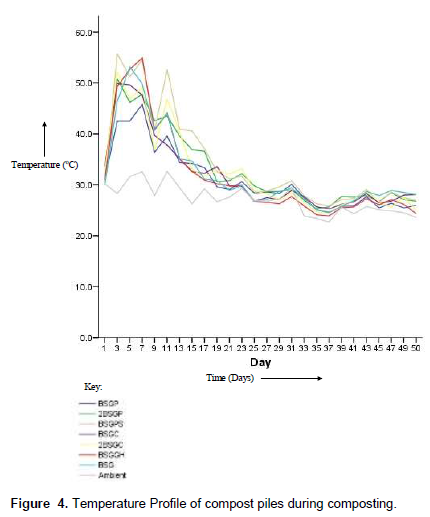
Microbial population of amendments
Total viable mesophilic bacteria counts were high in the first week of composting in all piles. BSGP had the highest population in week 1 being 5.8 x 107 cfu/g. Bacterial numbers declined in week 2 to as low as 1.5 x 104 cfu/g in BSG. The maximum bacterial count, 6.0 x 107 cfu/g was recorded in the 3rd week in the 2BSGC pile. After week 3, bacterial numbers generally declined to as low as 1.0 x 104 cfu/g in BSGP in the 7th week. This may have been as a result of reduction in carbon available for metabolism. The highest mean bacterial count obtained was 1.1 x 107 cfu/g (2BSGC) and the lowest was 2.7 x 106 cfu/g in BSG (Figure 5).
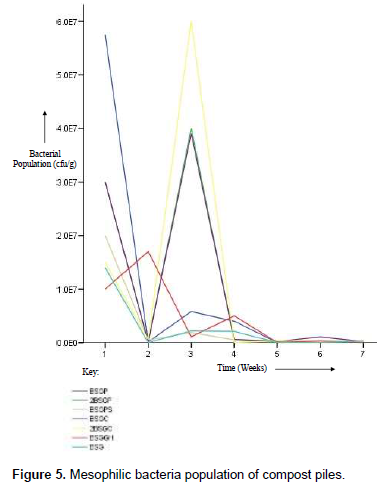
Fungal populations also were high in the first 3 weeks of composting. BSGGH had the maximum fungal population in the first week being 6.0 x 104 cfu/g. Fungal species isolated in the first week included Alternaria spp, Aspergillus spp, Mucor and Rhizopus spp. Spanning the entire period of composting, the mean fungal counts were 6.8 x 103 cfu/g for BSGP, 7.1 x 103 cfu/g for 2BSSGP, 5.1 x 103 cfu/g for BSGPS, 2.5 x 103 cfu/g for BSGC, 3.7 x 103 cfu/g for 2BSGC; 1.7 x 104 cfu/g and 5.0 x 103 cfu/g for BSGGH and BSG respectively (Figure 6).
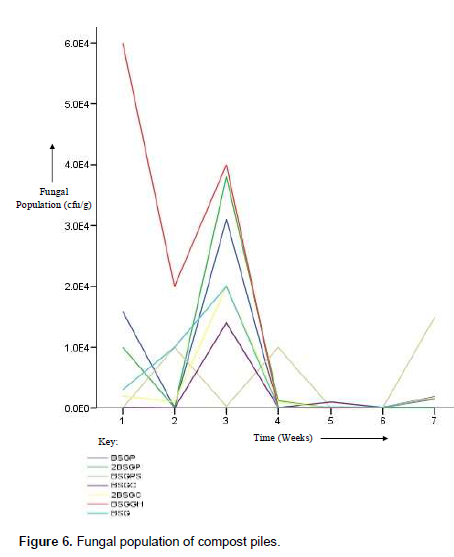
Actinomycetes population were initially low in the first three weeks of composting with the highest during this period recorded in 2BSGP being 9.0 x 106 cfu/g (Figure 7). There was an increase however in actinomycetes population starting from week 4 thus: BSGP, 3.0 x 107 cfu/g; 2BSGP, 5.0 x 105 cfu/g; BSGPS, 6.0 x 104 cfu/g; BSGC, 3.0x 106 cfu/g; 2BSGC,BSGGH and BSG, 2.0 x 105 cfu/g, 4.0 x 104 cfu/g and 4.0 x 105 cfu/g respectively. The increase in actinomycetes number after the 4th week may be due to lower competitive stress effected by lower bacterial and fungal counts. The pattern of compost colonization by actinomycetes in this study is consistent with that reported by Golueke et al. (1954) and Davis et al. (1992). BSGPS had the highest actinomycetes count of 5.6 x 107 cfu/g in the 7th week. The highest mean actinomycetes count of 1.0 x 107 cfu/g was recorded in BSGGH and the lowest, 1.3 x 106 cfu/g in BSG.
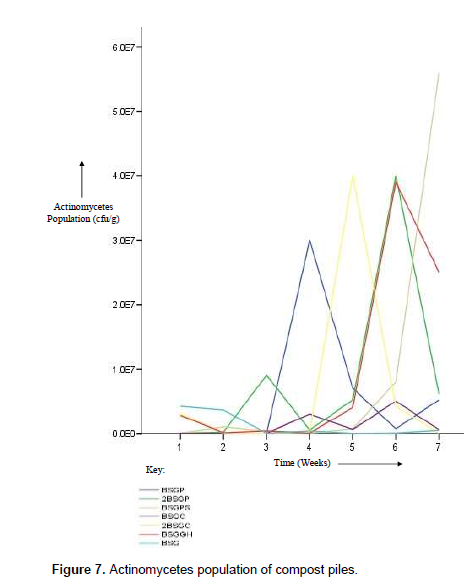
There was no significant differences (P=0.899) in microbial counts across treatment levels suggesting that substrate composition of compost piles is not a limiting factor to microbial numbers and succession during com-posting. Results of this study show that the presence of activators alongside carbon-rich bulk material however is a determinant of microbial population. This is supported by the fact that mean bacterial (2.7 x 106 cfu/g), mean fungal (5.0 x 103 cfu/g) and mean actinomycetes (1.3 x 106 cfu/g) counts were lowest in the control pile (devoid of activators) in this study and in a separate research that investigated the effects of activators during composting of threshed palm fruit bunches reported by Chukwudi (2011).
Compost stability indices
Dewar Self-Heating Test
Highest maximum temperature increases were observed in BSGGH (8.10°C), 2BSGC, BSGC, and BSGP composts (all 8.00°C). Compost samples from the three other piles (2BSGP, BSGPS, BSG) all had highest maximum temperatures of 7.00°C. All the compost piles were thus deemed very mature since they all had lower than 10oC as maximum temperature rise over ambient during the 7 day test period (Council, 2001).
Germination index
The two indexes measured in the germination test were Soybean plants’ root and shoot length (RL and SL) in centimetres. The mean RL of the control plants was 1.10 cm and the mean shoot length was 4.90 cm. Mature compost must produce plants indexes (RL and SL) longer than 90 % of those of the control, soil only (Council, 2001). Plants in the compost pots 1-7 all had RL and SL longer than 0.99 cm (90 % of mean root length of control plants) and 4.90 cm (90 % of mean shoot length of control plants); hence all compost piles were deemed mature. Compost stability indices obtained in this study were consistent with those reported in a separate investigation (Chukwudi, 2011).
Mechanical durability of compost pellets
Pellets made from BSGP and BSGPS had the least abrasion values being 10%, pellet made from BSGC had 15%, 2BSGC pellet had 18% while 2BSGP, BSGGH and BSG pellets had 20, 30 and 40% abrasion respectively. Relatively low abrasion values of pellets containing poultry waste (BSGP, 2BSGP and BSGPS pellets) suggest better binding capacity of constituents. High abrasion value of the control (BSG only) suggests high friability of pellets. From these data it could be clarified that compost with higher percentage of organic nitrogen or with lower percentage of carbon is constituent form for better pellets.
Agronomic evaluation
Heights of Zea mays
The tallest plant was obtained from the ‘NPK’ plot being 221 cm. Plant height of 203 cm was recorded in BSG-treated plot while BSGPS treated plot recorded 200 cm tall. The least height was obtained in the ‘Soil-only’ control plot being 127 cm (Figure 8). Mean plant heights in BSGP, BSGC and BSGPS treated plots were higher than that of the control plot (Soil-only) by 46.18, 37.02, and 49.24 % respectively. Mean plant height of BSGPS treated plot was higher than that of NPK treated plot by 2.29%.
Yield of Zea mays
Figure 9 shows the grain yield of maize plants. Mean grain yield was highest in the BSGPS plot being 306 g. The mean grain yields of BSGP, 2BSGP, BSGPS, 2BSGC, and BSGGH treated plants was higher than that of untreated maize plants by of 15.88, 18.13, 37.25, 22.63, 21.00, and 29.88 g respectively. BSGPS treated plants exceeded the mean grain yield of NPK treated plants by 4.25 g. Post – hoc analysis (Tukey’s honest significant difference) showed that significant differences existed (p = 0.05) in the effect of BSGPS and BSGGH amendments on grain yield over the control which compared favourably with the effect of NPK fertilizer over the control (soil only). This result is in concord with the findings of Amoding et al. (2005). The increase in plant height and grain yield in the BSGPS plants may be attributed to high contents of primary elements required for plant growth in BSGPS compost; with C:N being 15:1, Mg (9.2 CMol/kg), K (8.21 CMol/Kg) and P (387.03 ppm); in agreement with the postulations of Bender and Faber (2007).
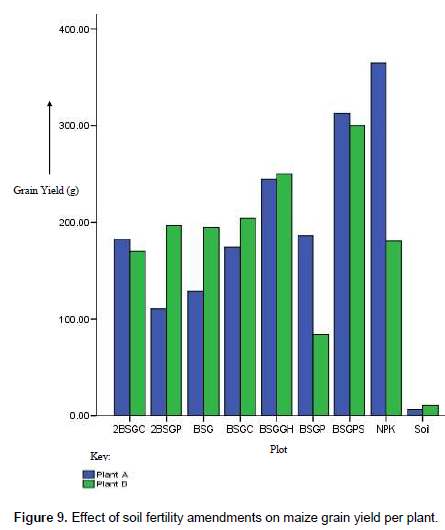
CONCLUSIONS AND RECOMMENDATION
Brewer’s spent grains can be used as a soil fertility amendment alongside items currently tagged as ‘wastes’ such as poultry droppings, soybean meal and groundnut husks (poultry waste mixed with soybean meal gave the best plant-yield results in this study). Results from this research have shown that in appropriate mixtures, these materials could be refined by microorganisms into agricul-turally important soil conditioners. The product can be stably pelletized for improved storage, transportation and handling. The pelletized compost can compete favourably with commercially available inorganic fertilizers in terms of yield of staple crops like Zea mays.
Using brewer’s spent grains in the production of organic fertilizers will help in reducing the waste currently generated in the brewing industry and also provide more affordable alternatives to inorganic fertilizers in wide contemporary farming application.
From the results of this study, poultry droppings and soybean meal mixed in equal ratio are recommended as activators for compost production from brewer’s spentgrains especially for the cultivation of Zea mays.
The author(s) have not declared any conflict of interests.
REFERENCES
|
Alsup S (2008). Evaluation of metal leachability from green roof systems and components. ProQuest 20.
|
|
|
|
Amoding A, Tenywa JS, Ledin S,Otabbong E (2005). Agronomic effectiveness of urban market crop waste compost on-farm in Uganda. Afr. Crop Sci. Soc. Proc. pp.1133-1138.
|
|
|
|
|
Baharuddin AS, Wakisaka M, Shirai Y, Abd-Aziz S, Rahman NAA,Hassan MA (2009). Co-composting of empty fruit bunches and partially treated palm oil mill effluents in pilot scale. Int. J. Agric. Res. 4(2):69-78.
Crossref
|
|
|
|
|
Bajpai P (2011). Biotechnology for pulp and paper processing. Springer Science & Business Media, 343.
|
|
|
|
|
Bender G, Faber B (2007). Avocado fertilization. The macro elements. San Diego: UC Cooperative Extension.
|
|
|
|
|
Brock T (1978). Thermophilic microorganisms and life at high temperatures. New York: Springer Verlag, 40.
Crossref
|
|
|
|
|
Chukwudi O (2011). Effect of different activators on the composting of threshed palm fruit bunches M.Sc. Dissertation to the Department of Microbiology. Obafemi Awolowo University,Ile-Ife, 110.
|
|
|
|
|
Council CCQ (2001). Compost maturity index. 19375 Lake City Road Nevada City, CA 95959: California Compost Quality Council. Available at: www.ccqc.com.
|
|
|
|
|
Davis C, Hincha S, Donkina C, Germishuizenb P (1992). Changes in microbial population numbers during the composting of pine bark. Bioresour. Technol. 39(1):85-92.
Crossref
|
|
|
|
|
Eghball B, Power JF, Gilley JE,Doran JW (1997). Nutrient, carbon and mass loss during composting of beef cattle feedlot manure. J. Environ. Qual. 26:189-193.
Crossref
|
|
|
|
|
Epstein E (1996). The science of composting. Lancaster, PA: Technomic Publishing Company Inc, 56.
|
|
|
|
|
Erickson S, Prior M (1990). The briquetting of agricultural wastes for fuel. FAO.
|
|
|
|
|
Gershuny G (2011). Compost, vermicompost and compost tea: Feeding the soil on the organic farm. Chelsea Green Publishing, 104.
|
|
|
|
|
Golueke CG, Card BJ, McGauhey PH (1954). A critical evaluation of inoculums in composting. Appl. Microbiol. 2(1):45-53.
Pubmed
|
|
|
|
|
Hao X, Chang C, Larney F, Travis G (2001). Greenhouse gas emissions during cattle feedlot manure composting. J. Environ. Qual. 30:376-386.
Crossref
|
|
|
|
|
Loecke TD, Liebman M, Cambardella CA, Richard TL (2004). Corn growth responses to composted and fresh solid swine manures. Crop Sci. 44: 177-184.
Crossref
|
|
|
|
|
Lowe R (2005). Judging pellet stability as part of pellet quality. Feed Tech. 9(2):15-19.
|
|
|
|
|
Lundin C (2007). When all hell breaks loose: Stuff you need to survive when disaster strikes. Gibbs Smith, 450.
|
|
|
|
|
MAFF (1986). The analysis of agricultural materials Reference Book London: HMSO, 427.
|
|
|
|
|
Martins O, Dewes T (1992). Loss of nitrogenous compounds during composting of animal wastes. Bioresour. Technol. 42(2):103-111.
Crossref
|
|
|
|
|
Masayuki H (2001). Fertilizer pellets made from composted livestock manure. Kawasakita, Japan: Food and Fertilizer Technology Centre, 1-11. Available at: http://www.agnet.org/library.php?func=view&id=20110801154610.
|
|
|
|
|
Mongillo JF (2000). Encyclopedia of environmental science. University Rochester Press, 87.
|
|
|
|
|
Neher D, Weicht T, Bates S, Leff J, Fierer N (2013). Changes in bacterial and fungal communities across compost recipes, preparation methods, and composting times. PLoS One 8(11): e79512.
Crossref
|
|
|
|
|
Ogunwande GA, Osunade JA, Adekalu KO,Ogunjimi LAO (2008). Nitrogen loss in chicken litter compost as affected by carbon to nitrogen ratio and turning frequency. Bioresour. Technol. 99(16): 7495-7503.
Crossref
|
|
|
|
|
Prescott H (2002). Laboratory exercises in microbiology. 5th. The McGraw-Hill Companies. pp. 305-309.
|
|
|
|
|
Satyanarayana T, Johri BN, Prakash A (2012). Microorganisms in sustainable agriculture and biotechnology. Springer, 829.
|
|
|
|
|
Smith DR, Cawthon DL, Sloan JJ, Freeman TM (2006). In-vessel, mechanical rotating drum composting of institutional food residuals. Compost Sci. Util. 14(2):155-161.
Crossref
|
|
|
|
|
Stoffella PJ, Kahn BA (2001a). Compost utilization in horticultural cropping systems. CRC Press, 38-39.
|
|
|
|
|
Stoffella PJ,Kahn BA (2001b). Compost utilization in horticultural cropping systems. CRC Press, 308-310.
|
|
|
|
|
Strom P (1985). Effect of temperature on bacterial species diversity in thermophilic solid-waste composting. Appl. Environ. Microbiol. 50(4):899-905.
Pubmed
|
|
|
|
|
Szmidt RM (1997). Microbiology for environment and public health engineering. New York Press, 200.
|
|
|
|
|
Tiquia SM, Richard TL, Honeyman MS (2002). Carbon, nutrient, and mass loss during composting. Nutr. Cycl. Agroecosyst. 62:15-24.
Crossref
|
|
|
|
|
USDA (2000). Composting Washington, D.C: Department of Agriculture, 637.
|
|
|
|
|
Wei YS, Fan YB, Wang MJ,Wang JS (2000). Composting and compost application in china. Resour. Conserv. Recycl. 30(4):277-300.
Crossref
|
|